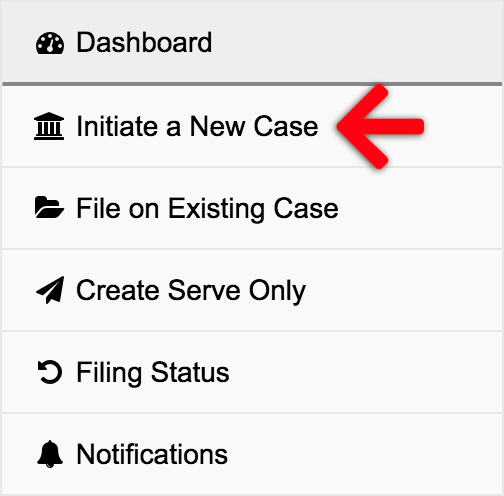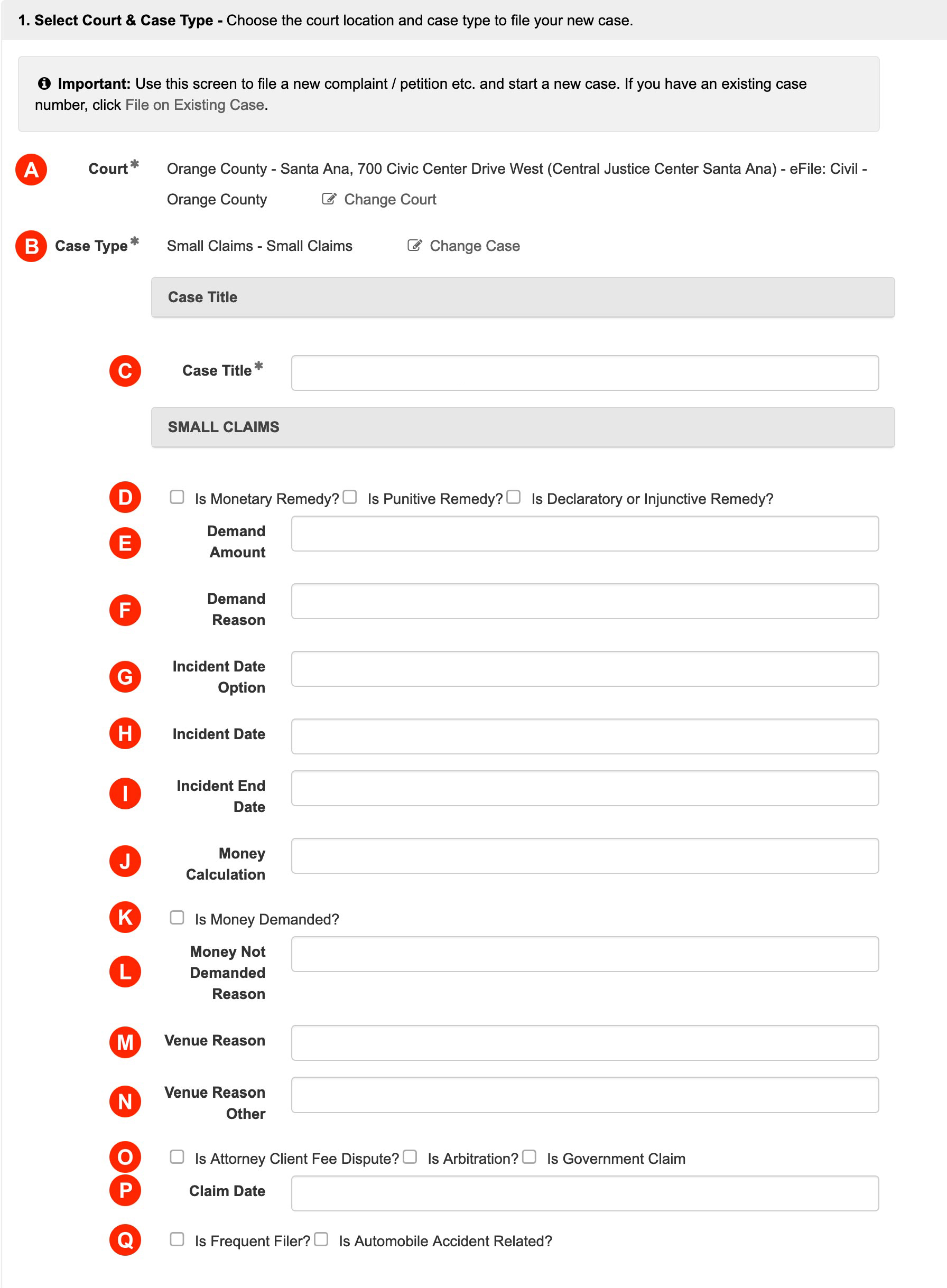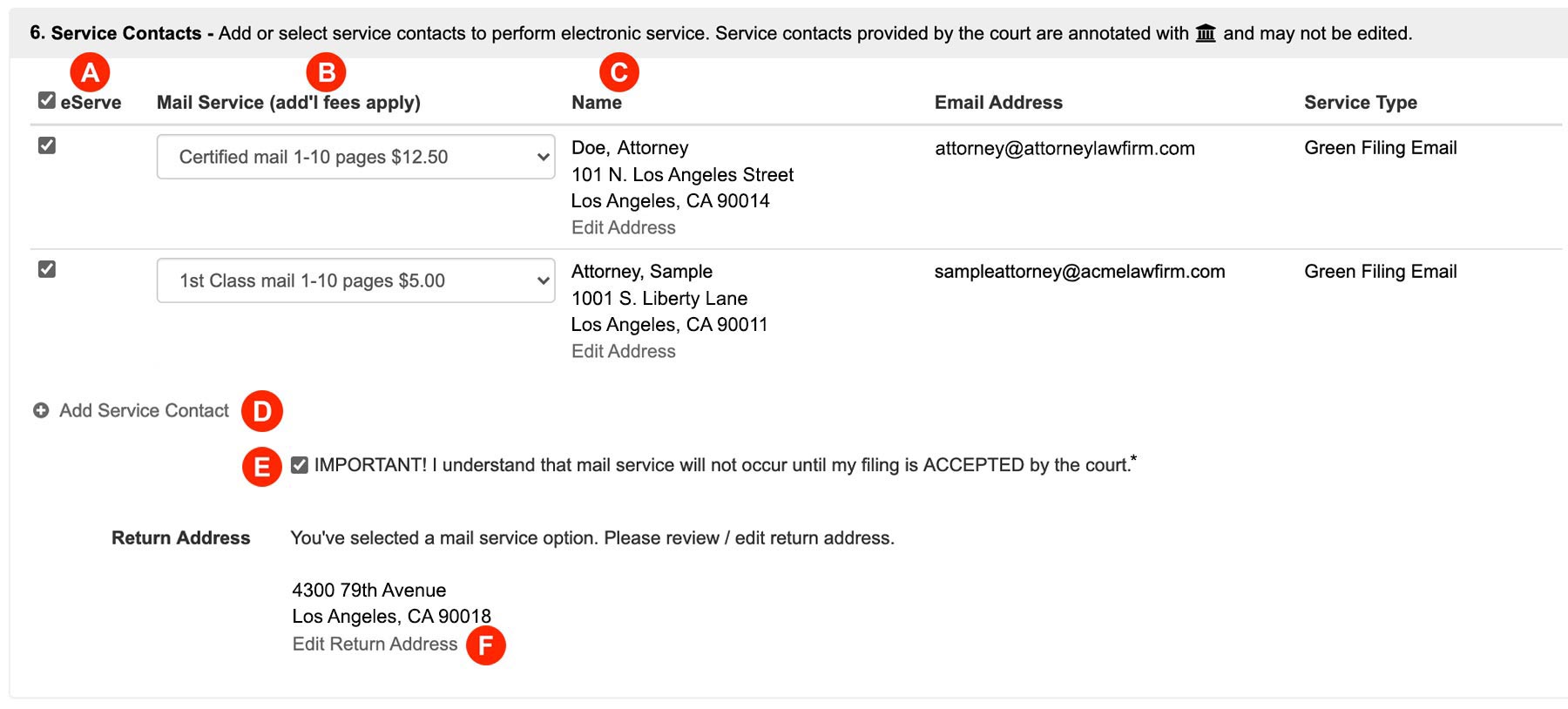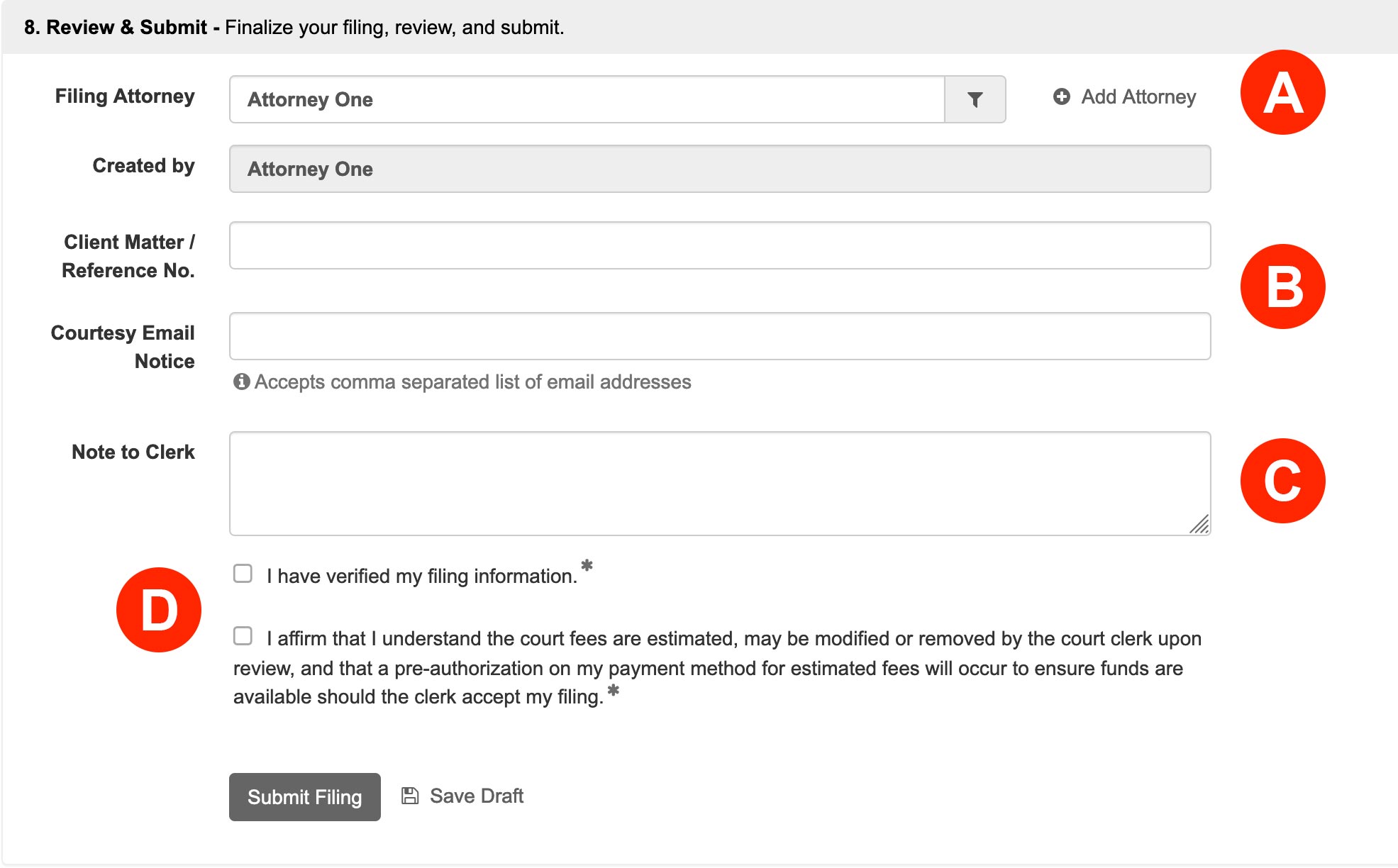These instructions are to initiate a new SMALL CLAIMS case in the Orange County Civil Court.
As always, if you have an existing Small Claims case number, you will want to file on that existing case—even if you have never filed on the case in our system before.
VIEW CALIFORNIA SMALL CLAIMS FAQS HERE
Initiate a New Case
Click the Initiate a New Case link from the left menu of the Dashboard to begin:
1. Select Court & Case Type – Choose the court location and case type to file your new case.
- Court – Choose your Orange County court location.
- Case Type – Choose the case type of Small Claims.
- Case Title – Enter your requested Case Title.
- Small Claims Check Boxes – Check any relevant box about your Small Claim.
- Demand Amount – How much money does the defendant owe you? (Question 3 on the SC-100)
- Demand Reason – Why does the defendant owe you money? (Question 3a on the SC-100)
- Incident Date Option
- If this happened on a specific date, enter SpecificDate in this field.
- If this happened over a period of time, enter OverTime in this field.
- Incident Date – If this happened on a specific date, enter that date here in the format of mm/dd/yyyy. If this happened over time, enter the start date here.
- Incident End Date – If this incident happened over time, enter the end date here in the format of mm/dd/yyyy (if applicable).
- Money Calculation – How did you calculate how much money is owed to you? (Question 3c on the SC-100)
- Is Money Demanded? – Check this box if you have asked the defendant—in person, in writing, or by phone—to pay you (or return any property that is yours). (Question 4 on the SC-100)
- Money Not Demanded Reason – If you have NOT asked the defendant—in person, in writing, or by phone—to pay you (or return any property that is yours), explain why not.
- Venue Reason
- Enter VenueReasonA in this field if you selected question 5a on the SC-100 – “The courthouse covers the area where: (a) the defendant does business, (b) your property was damaged, (c) you were injured, or (d) a written or spoken contract was made, signed, performed, or broken by the defendant or where the defendant lived or did business when they made the contract.”
- Enter VenueReasonB in this field if you selected question 5b on the SC-100 – “The claim is about an offer or contract for personal, family, or household goods, services, or loans, and the courthouse covers the area where the buyer or lessee signed the contract, lives now, or lived when the contract was made.”
- Enter VenueReasonC in this field if you selected question 5c on the SC-100 – “The claim is about a retail installment contract (like a credit card), and the courthouse covers the area where the buyer signed the contract, lives now, or lived when the contract was made.”
- Enter VenueReasonD in this field if you selected question 5d on the SC-100 – “The claim is about a vehicle finance sale, and the courthouse covers the area where the buyer signed the contract, lives now, or lived when the contract was made, or where the vehicle is permanently garaged.”
- Enter VenueReasonOtherOption in the field if you selected question 5e on the SC-100.
- Venue Reason Other – If you selected question 5e on the SC-100, explain why you are filing at this courthouse.
- Additional Filing Check Boxes – Check any additional relevant boxes about your Small Claim.
- Claim Date – If you checked the “Is Government Claim” box in the section above, enter that claim date here in the format of mm/dd/yyyy.
- Frequent Filer Check Box – If you have filed more than 12 other small claims within the last 12 months in California, check this box (your filing fee will be higher).
2. Add Documents – Define, select, and upload the documents that make up your filing.
- Document Type – Select the document type Plaintiff’s Claim and Order to go to Small Claims Court or Plaintiff’s Claim and Order to Go to Small Claims Court (COVID-19 Rental Debt) and upload that PDF. Then add any additional documents if needed.
Please note: we would not be able to advise on what forms you will need to submit to the court for your Small Claims case. You will want to refer to the California’s Small Claims Website for further information. - Document Description – After making your selection, type the true document title in the document description field.
- Click to Upload – Click the Click to Upload link to add your document. We’ll automatically convert most native file formats (i.e. Word, WordPerfect, JPG, PNG, GIF, TIF) into the Court’s preferred Adobe PDF format, upon upload.
- Edit – Click the Edit button to edit a description, delete a document, or replace a document.
3. New Case Parties – Enter the required parties.
Each case type you choose has required parties that must be defined. You must list all the parties listed in your complaint, and they need to match the document’s spelling AND case 100% to increase your chances of the filing clerk accepting your submission.
Note – If your party name is something more than a First, Middle, and Last name, switch the TYPE field from Individual to Business.
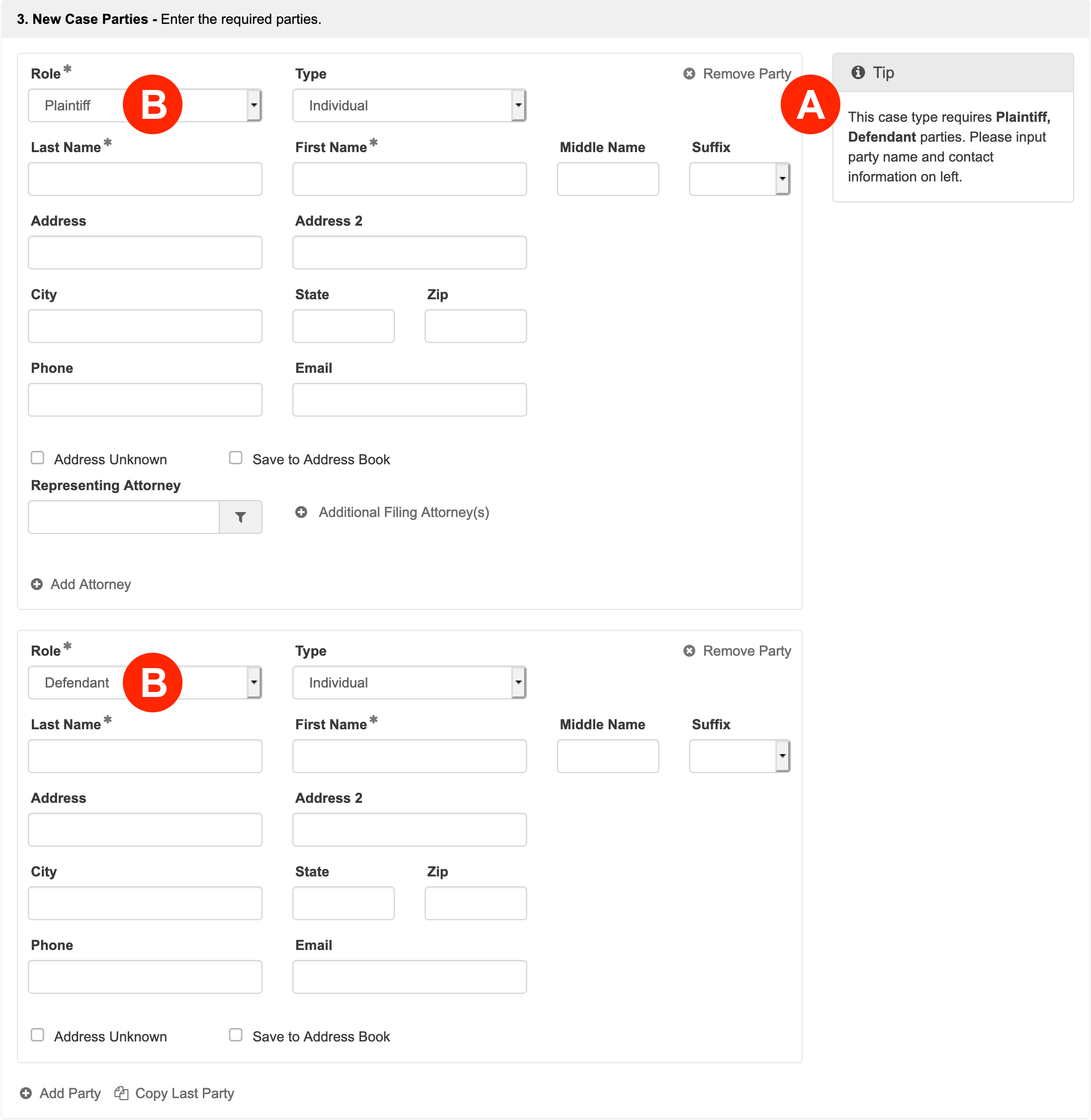
- Most states will alert filers to the roles they need defined via this Tip box.
- Some states will auto-populate the required roles in the parties section itself.
When filling out this section, you may select Representing Attorneys from the menu, or click the Add Another Attorney link to add them.
If you do not know your party’s address, you may click the Address Unknown checkbox.
4. Filing Party – Choose the party or parties you are filing on behalf of. If using a keyboard, select parties with the enter key instead of the spacebar.
5. Additional Info – Enter any additional information that is required, indicated by a *, for this filing type.

Click the button Check for Required Data to see if the court requires additional information from your uploaded document(s) before submitting.
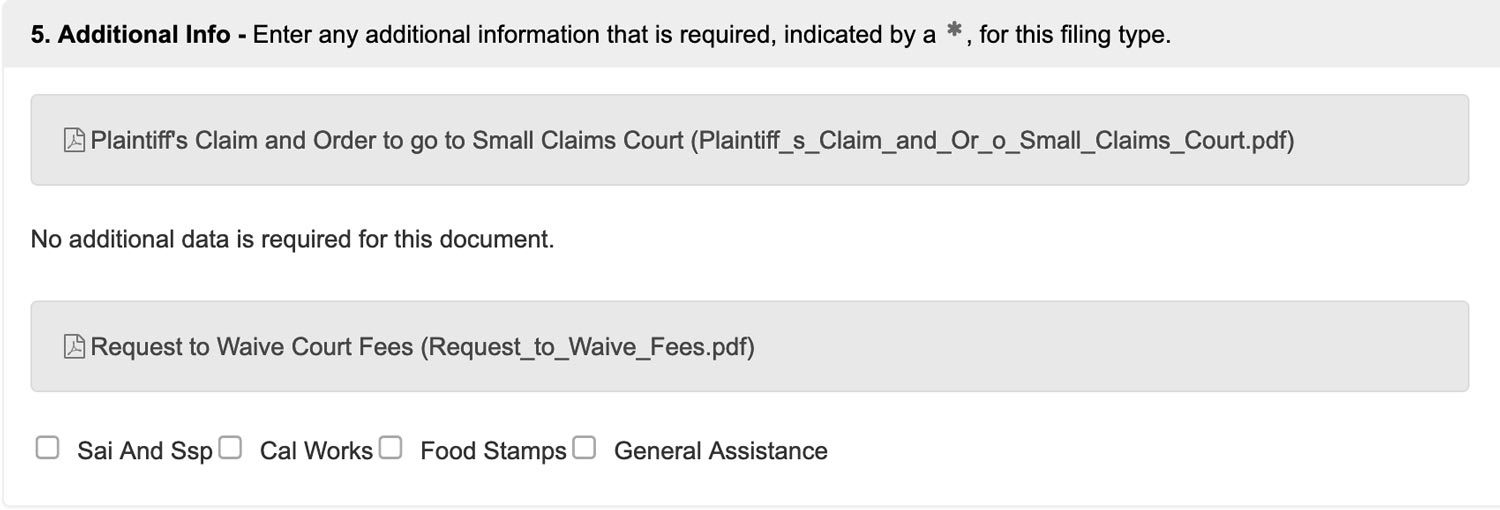 If you are submitting a Request to Waive Fees, you will want to select the appropriate check box for the request reason. Typically the choices are: Sai And Ssp, Cal Works, Food Stamps, or General Assistance.
If you are submitting a Request to Waive Fees, you will want to select the appropriate check box for the request reason. Typically the choices are: Sai And Ssp, Cal Works, Food Stamps, or General Assistance.
6. Service Contacts – Add or select service contacts to perform electronic service. Service contacts provided by the court are annotated with and may not be edited.
- eServe – Check any box in this column to electronically serve a party or attorney via email.
IF YOU DO NOT WANT THE OPPOSING PARTY (OR ANY PARTY) TO HAVE ACCESS TO A CONFIDENTIAL DOCUMENT NEVER E-SERVE THEM. E-SERVING A PARTY MEANS THAT YOU, THE FILER, CONSENTS TO THEM HAVING ACCESS TO THE DOCUMENT. - Mail Service – Select Certified or First Class Mail to serve a party or attorney via mail once the court accepts the filing.
- Name – a filer may add or edit an address for Mail Service. However, only the contact’s name shows until a user selects a Mail Service type in the previous column.
- Add Service Contact – click this link to add new contacts to a filing.
- Acknowledgment Checkbox – For those users who have requested mail service, check this box to acknowledge you understand mail service doesn’t go out until the court accepts the filing.
- Return Address – Verify the return address is accurate and correct in case any Mail Service is returned to you.
Learn More about Service Contacts and our new Mail Service via Certified and First Class Mail
7. Filing Fees – Select a payment method to pay estimated fees.
Fees Breakdown
Court Document Fees – If any of your Document Types have fees associated with them, the first row(s) will list the document with its associated fees. If this amount looks incorrect, filers will want to choose a different document type above.
Mail Service Fees – If the filer has requested any Service by Mail in the filing, those fees will be listed here.
Provider Service Fee – This is the fee your chosen provider (EFSP) charges for each accepted filing. Please refer to your EFSP for more information regarding their fees.
Payment Service Fee – The Payment Processor charges a fee of approximately 3% when a credit card is used, or a flat fee of up to $1 for an ACH payment.
Sales Tax – Sales tax may appear in the fees section because some state governments classify the e-filing service itself as a taxable transaction or service, requiring the payment processor to collect and remit the applicable state sales tax on the charge for filing.
Confirm Fees
Select Payment Account – Choose your payment type. Filers who select an ACH payment type will also need to select a credit card on file as backup. If you do not see your payment type, click the Add New Payment Method link below.
Confirm Fee Calculation – Click the Confirm Fee Calculation link to see the estimated fees. The filing fees auto-populate from the court based on the Document Type(s) selected and the Additional Information entered. If the fees seem incorrect, you may need to change one of these types above.
Please note that the Orange County filing clerk assess the fees upon review of the submission and they may add or subtract fees upon acceptance.
Add New Payment Method – If you do not see your payment type above or wish to add a new one, click this link to add it.
Waivers on a Case – If you are requesting a waiver of fees for your case, you will want to add a Request to Waive Fees Document in the Add Documents section as needed.
8. Review & Submit – Finalize your filing, review, and submit.
- If you are Filing for an Attorney select them from the menu or click the Add Attorney link.
- If your firm uses any sort of Client Matter No, enter it here. If you want an unofficial copy of the filing to go to anyone associated with the case, like a client, enter their email(s) here. Note: this is different from a service contact, and it, along with the client matter number, are for your internal purposes only.
- If your court has the option to leave the clerk a memo, enter any sort of note here in the Note to Clerk box.
- Review your entire filing for accuracy, Then check the box to acknowledge you have verified your filing information.
ONCE THE FILING IS SUBMITTED, NEITHER THE FILER NOR THE E-FILING VENDOR MAY CANCEL OR EDIT THE SUBMISSION.
Submit Your Filing
Click the Submit Filing button. Clicking this button, sends your filing directly to filing clerk’s queue at the Court for review. Once all documents are successfully sent to them, the Court will return an envelope number with the date and time they received the full submission. This will be the date and time for the file stamp in your accepted filing. Any filing the Court receives weekdays after 11:59PM, on the weekend, or Court Holiday receives an accepted file stamp of the next Court business day.
On the Filing Status Screen, you will now see your filing is listed as pending. You may return to this screen at any time to see the current status for it and any other filing. Depending on the Court, it can take as little as a minute to review the submission to a few hours to a full business day. If it takes longer than that, the Court may have a backlog they are working through. If you are ever concerned about the status of a submission, the best thing to do is contact the Court directly and provide them with the Envelope Number on your filing.
9. Pre-authorization of Fees
It is important to note that when you submit your filing, the court does a pre-authorization on your card for the filing fees. If the court rejects the filing, then they will not settle that pre-authorization, and it will eventually fall off your card within 3 to 10 business days from the date of the clerk’s rejection depending on your banking institution.
Learn more about the pre-authorization of fees
